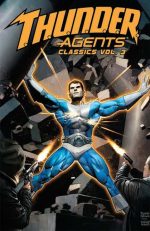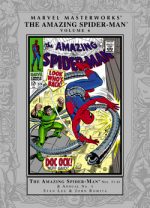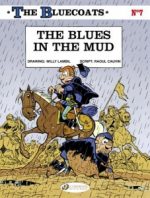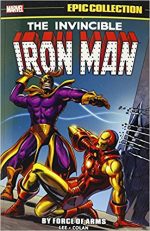
By Wally Wood, Len Brown, Bill Pearson, Steve Skeates, Dan Adkins, Reed Crandall, Gil Kane, Mike Sekowsky, George Tuska, Steve Ditko, Frank Giacoia, John Giunta & various (IDW) ISBN: 978-1-61377-941-5Â Â Â Â Â Â Â Â Â Â Â Â Â Â Â Â Â eISBN: 978-1-62302-543-4
The meteoric lifespan and output of Tower Comics is one of the key creative moments in American comicbook history. The brief, bombastic saga of The Higher United Nations Defense Enforcement Reserves was a benchmark of quality and sheer bravura fun for fans of both the then-still-reawakening superhero genre and the era’s spy-chic obsession.
In the early 1960s the Bond movie franchise was going from strength to strength, with blazing action and heady glamour utterly transforming the formerly low key espionage genre. The buzz was infectious: soon Men like Flint and Matt Helm were carving out their own piece of the action as television shanghaied the entire bandwagon with the irresistible Man from U.N.C.L.E. (premiering in September 1964); bringing the whole shtick inescapably into living rooms across the planet.
Archie Comics editor Harry Shorten was commissioned to create a line of characters for a new distribution-chain funded publishing outfit – Tower Comics. He brought in creative maverick Wally Wood, who called on some of the biggest names in the industry to produce material in the broad range of genres the company demanded (as well as T.H.U.N.D.E.R. Agents and its spin-offs Undersea Agent, Dynamo and NoMan, there was a magnificent anthology war-comic Fight the Enemy and wholesome youth-comedy Tippy Teen).
Samm Schwartz & Dan DeCarlo handled the funny funnybook – which outlasted everything else – whilst Wood, Larry Ivie, Len Brown, Bill Pearson, Steve Skeates, Dan Adkins, Russ Jones, Gil Kane and Ralph Reese contributed scripts for themselves and the industry’s other top talents to illustrate on the adventure series.
With a ravenous appetite for super-spies and costumed heroes growing in comic-book popularity and amongst the general public, the idea of blending the two concepts seemed inescapable…
T.H.U.N.D.E.R. Agents #1 appeared with no fanfare or pre-publicity on newsstands in August 1965 (with a cover off-sale date of November). Better yet, all Tower titles were in the beloved-but-rarely-seen 80-page Giant format, offering a huge amount of material in every issue.
All that being said these tales would not be so revered if they hadn’t been so superbly crafted. As well as Wood, the art accompanying the compelling, subtly more mature stories was by some of the greatest talents in comics: Reed Crandall, Gil Kane, George Tuska, Mike Sekowsky, Dick Ayers, Joe Orlando, Frank Giacoia, John Giunta, Steve Ditko and others.
This third lush and lustrous compilation collects T.H.U.N.D.E.R. Agents #8-10 and includes the second sterling spin-off issue of Dynamo – all originally released between September and November 1966 – with the incomparably cool concept and characters going from strength to strength and a spirit of eccentric experimentation slipping in to sweeten the pot…
For those who came in late: When brilliant Professor Emil Jennings was attacked by the forces of the mysterious Warlord, the savant perished. Happily, UN troops salvaged some of his greatest inventions, including a belt that increased the density of the wearer’s body until it became as hard as steel, a cloak of invisibility and a brain-amplifier helmet…
The prototypes were divided between several agents to create a unit of super-operatives to counter increasingly bold attacks of multiple global terror threats such as the aforementioned Warlord.
First chosen was affable, honest but far from brilliant file clerk Len Brown who was, to everyone’s surprise, assigned the belt and codename Dynamo. Contributing scripter Len Brown had no idea illustrator/editor Wood had puckishly changed the hero’s civilian name as a last-minute gag until the comic rolled off the presses…
T.H.U.N.D.E.R. Agent NoMan was once aged Dr. Anthony Dunn who chose to have his mind transferred into an android body and was then gifted with the invisibility cape. If his artificial body was destroyed Dunn’s consciousness could transfer to another android body. As long as he had a spare ready, he could never die…
Guy Gilbert of the crack Mission: Impossible style T.H.U.N.D.E.R. Squad was asked to beta-test an experimental super-speed suit. Gung-ho Lightning was proud to do so, even if every use of the hyper-acceleration gimmick shortened his life-span…
John Janus seemed the perfect UN employee: a mental and physical marvel who easily passed all the tests necessary to wear the Jennings helmet. Sadly, he was also the Warlord’s mole, poised to betray T.H.U.N.D.E.R. at the earliest opportunity. All plans went awry however, once he donned the helmet and became Menthor.
The device awakened his mind’s full potential, granting him telepathy, telekinesis and mind-reading powers, but it also drove all evil from his mind. Such was the redemptive effect that Janus actually gave his life to save his comrades: an event which astounded readers at the time…
This third intense Intelligence compendium opens with T.H.U.N.D.E.R. Agents #8 as Dynamo is caught up in a huge multi-state power cut that turns out to be sabotage perpetrated by maverick Warlord Oro. Although the under-Earth evildoer leaves ‘Thunder in the Dark’ (by an unknown author and art by Wood, Adkins & Reese) he is unable to stave off the dogged, determined destruction dealt out by Dynamo…
Invisible agent NoMan then infiltrates ‘The Pyramid of the Warlords’ (Pearson, John Giunta & Joe Giella) and wipes out a hidden horde of the malevolent miscreants whilst super-speedster Lightning investigates tech-stealing ET ‘The Blue Alien’ (Steve Skeates, Sekowsky & Frank Giacoia) only to discover and old enemy using a new gimmick…
With the Warlords using anti-gravity gimmicks, the T.H.U.N.D.E.R. bigwigs are forced to innovate and create a flying agent in ‘Enter the Raven’ (Skeates, & Tuska), but have second thoughts after unscrupulous former mercenary Craig Lawson proves to be the only contender capable of piloting the heavily-armed flight-kit…
Following a stunning ‘Warlord Pin-up’ by Wood & Reese, the issue ends with an ensemble team-up as the T.H.U.N.D.E.R. Agents unite in a ‘Final Encounter’ (Wood & Adkins over another anonymous script) that ranges from the bowels of the Earth to the edge of space and seemingly sees the death of the supreme Warlord…
A new era opened with T.H.U.N.D.E.R. Agents #9 as affable agent Len Brown is asked to go undercover on an army base in ‘Corporal Dynamo, USA’ (with art from Giunta & Wood). The hunt for traitors selling stolen weapons to subversive sect S.P.I.D.E.R. ends explosively and leads into Lightning’s solo pursuit of modern Prometheus ‘Andor’ (illustrated by Sekowsky, Giacoia & Giella).
Long ago the Warlords stole a human baby and spent decades turning the waif into a biological superman devoid of sentiment or compassion. Sadly, they lost all control of the living weapon once he met fellow mortals. Now, the pitiful misfit’s attempts to rejoin mankind are derailed when a surviving Subterranean re-establishes mental dominance and again tries to crush the surface world…
Giunta limns NoMan’s investigation of ‘The Secret of Scorpion Island’ wherein a UN vaccination program is hijacked to create a pool of chemically-enslaved cultists for a deranged mastermind after which the assembled T.H.U.N.D.E.R. Agents contest with numerous rival agencies to secure a lethal outer space threat concealed within ‘The Black Box of Doom’ (Adkins & Chic Stone)…
The issue then concludes with a peculiarly quirky tale very much of its time as winged wonder ‘Raven Battles Mayven the Poet’, written and illustrated by legendary craftsman Manny Stallman.
A star from the get-go, Dynamo quickly won his own blockbuster-sized solo title. With an October cover-date, #2 kicked off with the husky hero firmly trapped in ‘The Web of S.P.I.D.E.R.’ (Stone, Wood & Adkins) after he storms into the country the evil empire has illegally annexed. He’s not completely alone, however: sinister sultry siren Iron Maiden is on hand to offer temptation and salvation in equal amounts…
Evil never rests though and in ‘S.P.I.D.E.R. Strikes at Sea!’ (Wood & Adkins) the covert creeps swipe an atomic submarine aircraft carrier and only Len can save the day and return the super-weapon…
Dynamo proudly boasts he’s more brawn than brains which doesn’t help when he has to solve the mystery of ‘The Priceless Counterfeit!’ (Dick Ayers, Wood & Adkins) statue S.P.I.D.E.R. wants to smuggle out of America…
Following a brace of pin-ups – ‘Red Star’ by Sekowsky & Giacoia and ‘Andor’ by Adkins – Dynamo is targeted for assassination by the rival Red Star and S.P.I.D.E.R. gangs in ‘Between Two Enemies’ (Sekowsky & Stone) before T.H.U.N.D.E.R. Agent Weed comedically wraps things up as his dreams of becoming a super-operative bring him into contention with howling maniac ‘The Hyena’ – a Tuska-illustrated gem sadly lacking an author credit as do so many of the tales in this collection…
T.H.U.N.D.E.R. Agents #10 is the last issue compiled here and opens with Dynamo actually outclassed after S.P.I.D.E.R. springs a number of old foes from jail. Rendered by Wood, ‘Operation Armageddon’ finds T.H.U.N.D.E.R. on the ropes and the muscle-headed muscleman running for his life when personal nemesis Demo steals a machine that fires miniature atom bombs. Sadly the sick killer never realised affable Len Brown could be pushed too far…
Sekowsky, Giacoia & Giella then illustrate Lightning racing after the madman who invented ‘The Air Laser’ whilst Ogden Whitney signs in to draw a team-up of NoMan and Andor as the Warlord’s superhuman pawn hunts down his former masters but is captured once more and compelled to commit ‘Three Deeds of Evil’…
When communist brainwashing turns a trusted T.H.U.N.D.E.R. Agent into a liability the heroes gather to save their comrade in ‘Kitten or Killer’ (Tuska art) and turn the tables before High Spy Raven brings the dramas to a close when ‘The Return of Mayven’ (Stallman) finds the poet and robotics expert again using exploding artificial children to sow chaos across America…
With stories all shaded in favour of fast pace, sparse dialogue, explosive action and big breathtaking visuals, T.H.U.N.D.E.R. Agents was decades ahead of its time and certainly informed everything in Fights ‘n’ Tights comics which came after it. These are truly timeless comic classics which improve with every reading, so do yourself a favour and add these landmark super-sagas to your collection.
T.H.U.N.D.E.R. Agents Classics volume 3 © 2014 Radiant Assets, LLC. All rights reserved.











